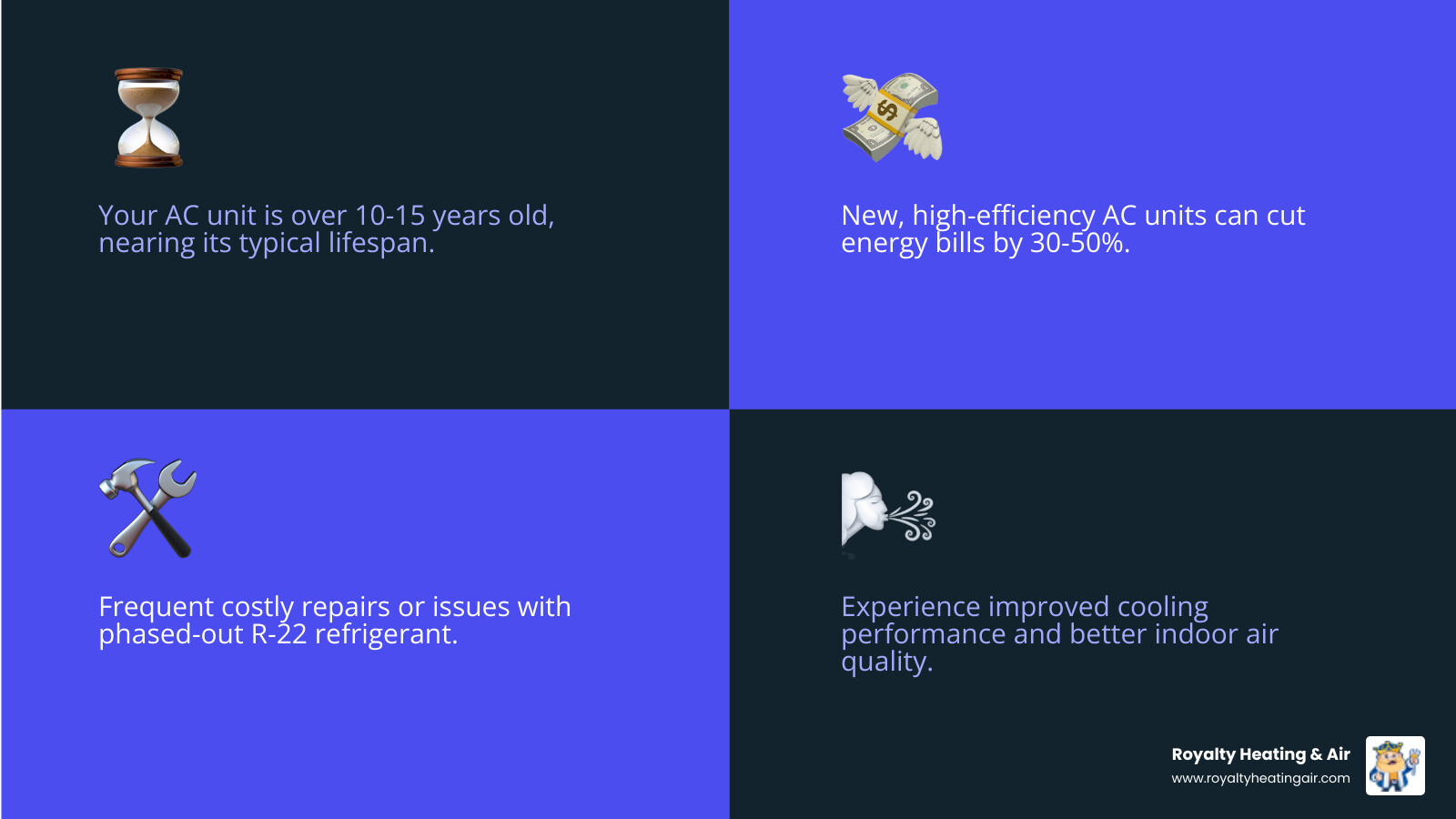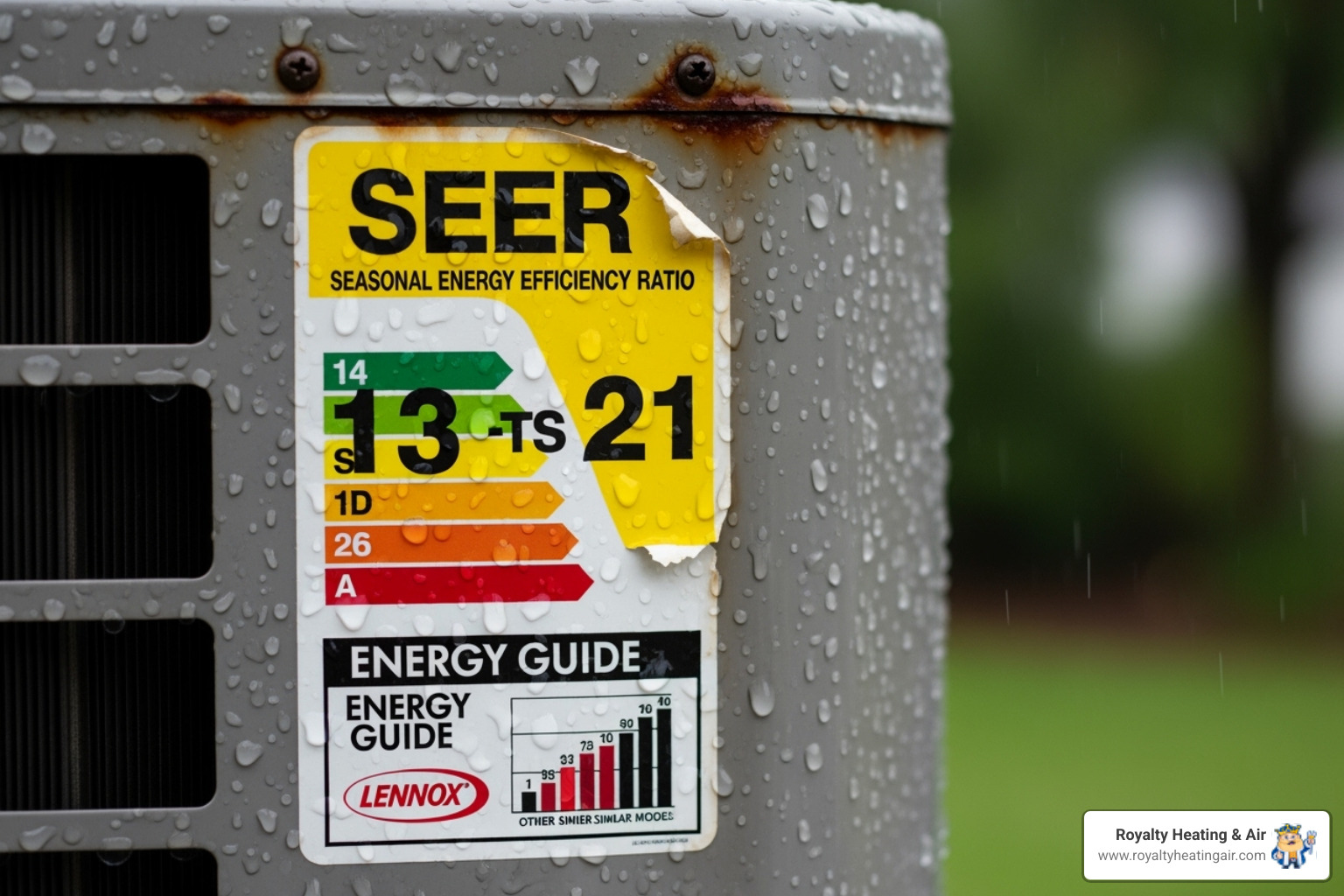When your air conditioner starts to fail, you face a big decision: repair or replace? An aging unit, frequent breakdowns, or rising energy bills are all signs that a new system might be the smarter choice. Modern, high-efficiency units can significantly reduce your energy consumption, often by 30-50%. This guide will help you recognize when it's time for an AC unit replacement, choose the right system, and understand the installation process.
Signs You Need AC Replacement:

Deciding between repair and replacement comes down to reliability, safety, and performance. Understanding the specific indicators helps homeowners make an informed choice that balances immediate costs with long-term value.
Air conditioners typically last 10-15 years with proper maintenance. Units approaching or exceeding this age often experience declining efficiency and increased failure rates. Performance degradation manifests through:
Older units using R-22 refrigerant face particular challenges. This refrigerant was phased out due to environmental concerns, making repairs increasingly expensive and eventually impossible. Chronic refrigerant leaks not only harm the environment but indicate deteriorating coils or connections that become costlier to fix over time. Modern systems use R-410A or newer R-32 refrigerant, offering better efficiency and environmental compatibility.
Several issues warrant immediate replacement consideration:
Your AC's performance depends heavily on proper ductwork. Problems include:
Before deciding, request these diagnostic tests:
These tests pinpoint whether equipment, ducts, or installation issues are the root cause of problems.
For units under 10 years old using current refrigerant with a single isolated fault, repair often makes economic sense. However, if two or more major issues apply—especially age combined with efficiency problems or safety concerns—replacement typically restores dependable comfort while reducing energy consumption by 30-50%. Consider total ownership costs over the next 5-10 years, including projected repair expenses, energy costs, and potential comfort compromises when making your decision.
Once you've decided that an AC unit replacement makes sense, focus on right-sizing, real-world efficiency, and features that fit your home and climate. The selection process involves understanding efficiency ratings, proper sizing methodology, and how your home's characteristics influence system performance.

SEER2 represents the current U.S. standard for rating AC efficiency under real-world conditions, replacing the older SEER rating system. According to Energy.gov's guide on central air conditioning, modern high-efficiency units can reduce cooling costs by 20-50% compared to 10-year-old systems. For California homes, minimum requirements start at SEER2 14.3 for most split systems, but higher ratings provide additional savings.
In hot-dry climates, EER2 (efficiency at high outdoor temperatures) becomes equally important. While SEER2 measures seasonal average efficiency, EER2 indicates performance during peak heat—critical for maintaining comfort during 100°F+ days. Look for units with EER2 ratings of 11.2 or higher for optimal hot-weather performance.
Modern systems offer technologies that significantly improve comfort beyond basic cooling:
Two-stage and variable-speed compressors adjust output to match cooling demand, running longer at lower speeds for better humidity removal and more consistent temperatures. These systems eliminate the temperature swings common with single-stage units.
Variable-speed indoor blowers provide precise airflow control, improving dehumidification by 10-15% compared to single-speed models. They also operate more quietly and distribute air more evenly throughout your home.
Advanced control systems with communicating technology coordinate all components for optimal performance. Smart thermostats can learn your schedule, adjust for outdoor conditions, and provide detailed energy usage reports.
Proper sizing remains the most critical factor in system performance. Oversized systems short-cycle, failing to run long enough for effective dehumidification while creating uncomfortable temperature swings. Undersized systems run continuously without achieving set temperatures, increasing wear and energy costs.
Professional sizing requires three interconnected calculations:
These calculations consider factors homeowners might overlook: heat gain from appliances, thermal mass of building materials, and microclimate variations around your property. Our team performs these comprehensive assessments for homes in Roseville, CA and surrounding communities.
Home improvements significantly affect cooling requirements. Room additions increase load proportionally, but other changes have subtler impacts:
Window upgrades from single-pane to low-E double-pane can reduce cooling load by 15-25%. Solar screens or awnings provide additional reductions. However, these improvements might mean your existing system becomes oversized, leading to efficiency and comfort problems.
Insulation and air sealing dramatically reduce cooling needs. Adding attic insulation from R-19 to R-38 can cut cooling load by 10-20%. Air sealing to reduce infiltration provides similar benefits while improving indoor air quality.
Ductwork improvements often provide the greatest return on investment. Sealing leaky ducts recovers lost capacity, while proper sizing and balancing ensures each room receives adequate airflow. If you're planning updates in areas like Granite Bay, CA, coordinate AC replacement with these improvements for optimal results.
California's diverse microclimates require custom approaches. Valley locations experience dry heat with large day-night temperature swings, benefiting from systems with excellent part-load efficiency. Foothill areas might need improved heating capabilities for cooler winters. Coastal influences in some regions introduce humidity concerns typically absent in inland areas. Your contractor should account for these local factors when specifying equipment.
Undergoing an AC unit replacement involves careful assessment, proper installation, and thorough commissioning so the system performs as designed.

Expect protective coverings in work areas, removal of the old equipment, precise placement of new components, proper line-set and drain routing, and a full performance test before handoff.
If your furnace is older or uses a non-ECM blower, pairing it with a modern AC can limit efficiency and comfort. A matched system ensures compatible blower airflow, control boards, coil sizing, and refrigerant metering—which supports performance, humidity control, and warranty compliance. Variable-speed, communicating systems are engineered to work as a set. For more information, see our blog on indicators it's time for furnace replacement.
An AC unit replacement involves more than swapping equipment. Understanding scope, code requirements, and available incentives helps homeowners plan effectively while maximizing value from their investment.

Several factors influence project complexity and duration:
Equipment specifications affect installation requirements. Higher SEER2/EER2 units often have larger coils requiring cabinet modifications. Variable-speed systems need compatible thermostats and potentially control wiring upgrades.
Duct system modifications frequently extend project scope. Proper airflow requires 400 CFM per ton of cooling, but many older duct systems fall short. Solutions range from simple sealing (2-4 hours) to complete redesign and replacement (1-2 additional days). Target static pressure below 0.5 inches water column ensures efficient operation and component longevity.
Electrical infrastructure must support new equipment. Modern units may require:
Refrigerant line considerations impact both timeline and cost. Existing line sets might need:
Condensate management prevents water damage and ensures proper operation:
Physical installation requirements vary by location:
Regulatory compliance adds steps but ensures safety:
Control system integration improves comfort but requires planning:
High-efficiency systems qualify for multiple incentive programs, potentially reducing net investment by 20-40%:
Federal tax credits offer up to 30% of equipment and installation costs for qualifying systems, with annual caps. Requirements include specific SEER2/EER2 ratings and AHRI certification.
State programs in California provide additional rebates for exceeding minimum efficiency standards. Some programs offer increased incentives for income-qualified households.
Utility rebates vary by provider but typically range from $200-$1,000 for high-efficiency installations. Many utilities require pre-approval and specific contractor qualifications.
Manufacturer promotions often combine instant rebates with extended warranties or free maintenance packages. Timing purchases during promotional periods can yield significant savings.
To position your project for maximum incentives:
Before installation:
During installation:
After installation:
Successful AC replacement requires coordinating multiple factors. Consider seasonal timing—spring and fall offer mild weather for precise commissioning while avoiding peak season scheduling challenges. Budget for potential findies like deteriorated ductwork or electrical deficiencies. Plan for 1-2 days without cooling during installation. Prepare access paths and protect landscaping from equipment movement. Clear communication with your contractor about expectations, timeline, and any special requirements ensures smooth project execution.
Most standard replacements are completed in a single day. Allow additional time if ducts need sealing/resizing, the refrigerant line set requires replacement, electrical upgrades are needed, or if permit/inspection or HERS testing is scheduled.
A matched system means the indoor coil/air handler (or furnace with coil) and outdoor condenser are rated together as an AHRI-certified pair. Proper matching ensures correct capacity, airflow, and refrigerant metering, which preserves efficiency, improves humidity control, and helps maintain warranty eligibility.
Spring and fall shoulder seasons typically offer easier scheduling and mild conditions that make commissioning and performance testing more precise before extreme weather arrives.
Replacing an aging AC improves comfort, air quality, and energy efficiency when the system is correctly sized, installed, and commissioned.
For homeowners in Roseville, Loomis, Rocklin, Lincoln, Granite Bay, and surrounding areas, Royalty Heating & Air provides expert AC replacement. Don’t wait for a mid-season breakdown—schedule your AC replacement in Sacramento so your home is ready for the heat.
